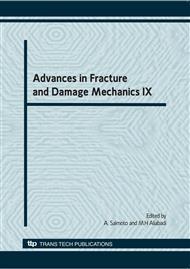p.285
p.289
p.293
p.297
p.301
p.305
p.309
p.313
p.317
Effects of Stitching Parameters of Non-Crimp Fabrics on the Mechanical Properties of CFRTP
Abstract:
The non-crimp fabric (NCF) have an advantageous combination of high material properties and low cost for processing, and overcomes the disadvantages of the crimp factor of woven fabrics, providing full use of modulus and strength of reinforcing fibre. For using NCF, different stitching tension and thread of non-crimp fabrics may cause the mechanical properties of CFRTP. In this study, it is aimed to clarify the effect of stitching tension and thread of non-crimp fabrics on tensile strength of CFRTP. The disorder degree of the thickness direction in the fibre bundle and the ratio of resin rich area were examined by the SEM image analysis. There is the inverse correlation between tensile strength and the disorder degree to the thickness direction in the fibre bundle.
Info:
Periodical:
Pages:
301-304
Citation:
Online since:
November 2010
Price:
Сopyright:
© 2011 Trans Tech Publications Ltd. All Rights Reserved
Share:
Citation:


